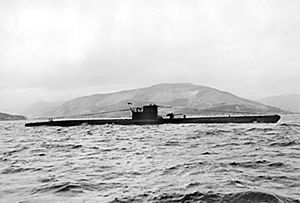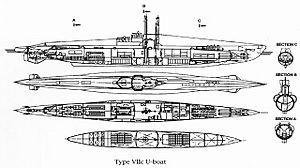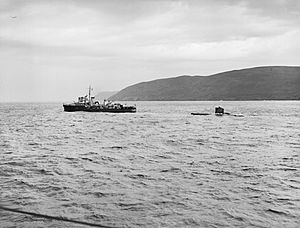German submarine U-991 facts for kids
class="infobox " style="float: right; clear: right; width: 315px; border-spacing: 2px; text-align: left; font-size: 90%;"
| colspan="2" style="text-align: center; font-size: 90%; line-height: 1.5em;" | 
|} The German submarine U-991was a type of U-boatcalled a Type VIIC. It was part of Nazi Germany's navy, the Kriegsmarine, during World War II.
Contents
| History | |
|---|---|
| Name | U-991 |
| Ordered | 25 May 1941 |
| Builder | Blohm & Voss, Hamburg |
| Yard number | 191 |
| Laid down | 30 October 1942 |
| Launched | 24 June 1943 |
| Commissioned | 29 July 1943 |
| Fate |
|
| General characteristics | |
| Class and type | Type VIIC submarine |
| Displacement | 864.7 t (851 long tons) submerged |
| Length |
|
| Beam |
|
| Height | 9.60 m (31 ft 6 in) |
| Draught | 4.74 m (15 ft 7 in) |
| Installed power |
|
| Propulsion |
|
| Speed |
|
| Range | |
| Test depth |
|
| Complement | 44–57 crew |
| Armament |
|
| Service record | |
| Part of: |
|
| Commanders: |
|
| Operations: |
|
| Victories: | None |
Building the U-991
The U-991 was started on 30 October 1942 at the Blohm & Voss shipyard in Hamburg, Germany. It was launched into the water on 24 June 1943. The submarine officially joined the navy on 29 July 1943. Its first commander was Oberleutnant zur See Diethelm Balke. The U-991's special symbol was a diving eagle.
When it was finished, the U-991 was about 67.10 metres (220 ft 2 in) long. It was 6.18 metres (20 ft 3 in) wide and 9.60 metres (31 ft 6 in) tall. The submarine weighed about 864.7 t (851 long tons) when it was underwater.
The U-991 used two powerful diesel engines for moving on the surface. These engines made a total of 2,800 to 3,200 metric horsepower (2,060 to 2,350 kW; 2,760 to 3,160 shp) of power. When underwater, it used two electric motors that produced 750 metric horsepower (550 kW; 740 shp). The submarine had two propellers to help it move.
It could dive to depths of up to 230 metres (750 ft). On the surface, its top speed was 17.6 knots (32.6 km/h; 20.3 mph) (about 32.6 km/h). Underwater, it could go up to 7.5 knots (13.9 km/h; 8.6 mph) (about 13.9 km/h). The U-991 could travel 8,500 nautical miles (15,700 km; 9,800 mi) (about 15,742 km) on the surface at a slower speed. Underwater, it could go 80 nautical miles (150 km; 92 mi) (about 148 km) at a slow speed.
The submarine was armed with five torpedo tubes. Four of these were at the front and one was at the back. It carried 14 torpedoes in total. It also had a deck gun and an anti-aircraft gun for defense. The crew of the U-991 was usually between 44 and 57 sailors.
U-991's Journey
The U-991 first served as a training ship. This was from 29 July 1943 to 31 August 1944. It was part of the 5th U-boat Flotilla during this time. After its training, it became an active combat submarine. It joined the 11th U-boat Flotilla on 1 September 1944.
Active Missions
During its active service, the U-991 went on one main patrol. It left Kristiansand, Norway, on 15 October 1944. This patrol lasted for 73 days. The submarine traveled through the North Atlantic Ocean. It went from Norway, around the United Kingdom and Ireland, and even near France. The patrol ended when the U-991 returned to Bergen, Norway, on 26 December 1944. This was its only combat patrol during World War II.
Here are the journeys U-991 made during its active service:
| Date | Starting Port | Arrival Port | Days Traveled |
|---|---|---|---|
| 5 – 7 October 1944 | Kiel | Horten | 3 days |
| 11 – 12 October 1944 | Horten | Kristiansand | 2 days |
| 15 October – 26 December 1944 | Kristiansand | Bergen | 73 days (Patrol) |
| 27 – 29 December 1944 | Bergen | Marviken | 3 days |
| 2 – 4 January 1945 | Marviken | Flensburg | 3 days |
| 20 – 27 April 1945 | Kiel | Horten | 8 days |
| 29 April – 4 May 1945 | Horten | Bergen | 6 days |
In total, the U-991 spent 98 days at sea during its active service. This was until 9 May 1945, when the war ended.
Surrender and Final Fate
The U-991 gave up to the Allied Forces on 9 May 1945. This happened in Bergen, Norway. After its surrender, the submarine was moved. It went from Bergen to Scapa Flow on 2 June 1945. Then, it was moved again to Loch Ryan on 5 June 1945.
The U-991 stayed at Loch Ryan until 11 December 1945. On that day, it was towed out to sea by a British Navy tugboat named HMS Freedom. This was part of an operation called Operation Deadlight. In this operation, many captured German U-boats were sunk.
The U-991 was sunk at 12:15 AM on 11 December 1945. It was in the North Atlantic Ocean, off the coast of Ireland. A torpedo from the British submarine HMS Tantivy sank it. The wreck of the U-991 still rests at these coordinates: 56°10′N 10°05′W / 56.167°N 10.083°W.



